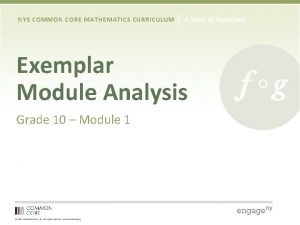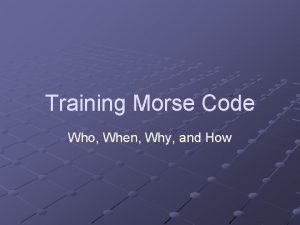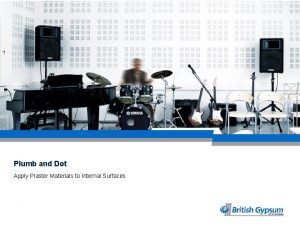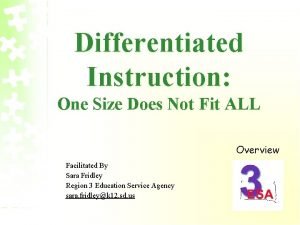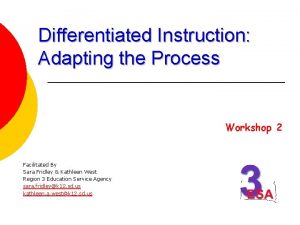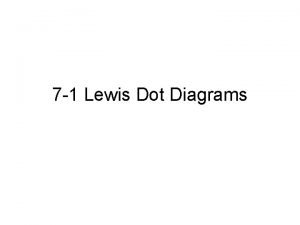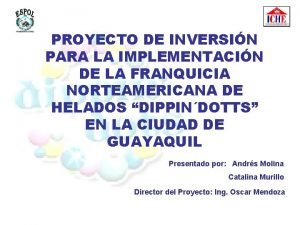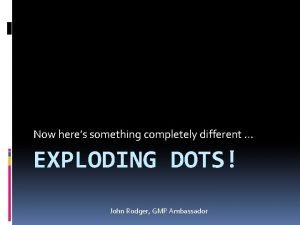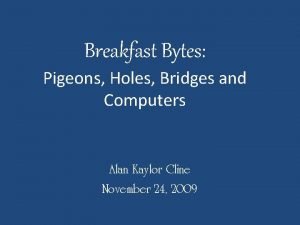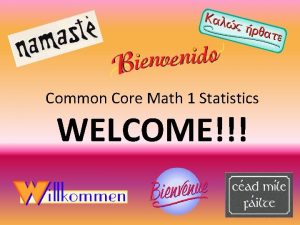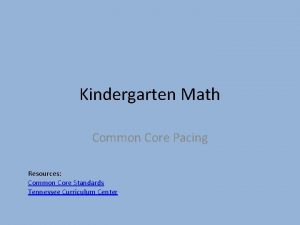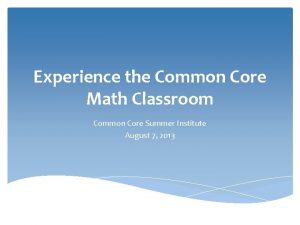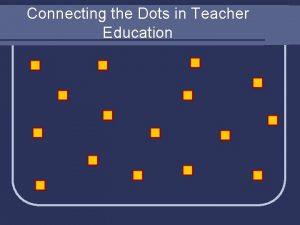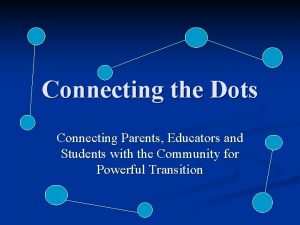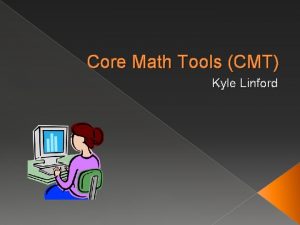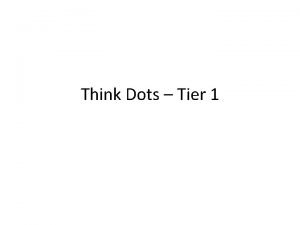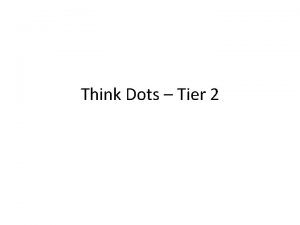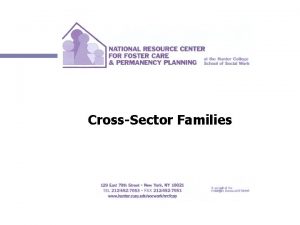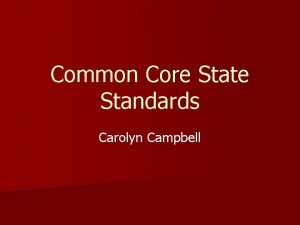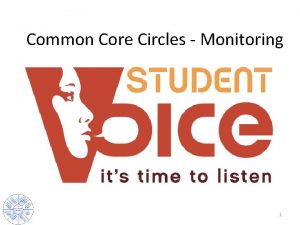Common Core Math Connecting the Dots for Families



























- Slides: 27

Common Core Math: Connecting the Dots for Families Mrs. Stefanie Stricker April 10, 2015

Here’s what Pennsylvania says. . . “Beyond state test scores and national assessments, the imperative for PA Core implementation is preparing our children to succeed in life after high school, in both post-secondary education and a globally competitive workforce. To that end, there is much work to be done. Although prior standards reflected quality and relevant content, the new standards are beyond the next new thing. The rigor of the new standards is deserving of a major shift in thinking about curriculum and delivery. ” Source: http: //static. pdesas. org/content/documents/Four%20 Guiding%20 Strategies%20 and%20 Key%20 Questions%20 12. 1. 2013. pdf

Here’s what the media says…. How do we know what to believe? source: Facebook

source: Facebook

Common Core and PA Core standards put an increased focus on: Collaboration Critical Thinking Creative Thinking Communication

Why we needed a change: There are 25 sheep and 5 dogs in a flock. How old is the Shepherd?

3 out of 4 students will give a numerical answer to this problem. Why?

Goal: Finding a Balance Between Memorizing Strategies AND Understanding Concepts! http: //lancasteronline. com/news/local/confusion-frustration-over-pennsylvania-core-leads-to-parent-mathnights/article_86 faf 73 c-a 7 ee-11 e 4 -985 b-af 5 a 80793 f 98. html

Teacher Survey Results:

Major Shifts in Kindergarten: ● Increase in number operations and computations ● Composing and decomposing numbers from 1 -20

Kindergarten Teachers’ Advice to Parents: “Encourage your child to show work or act out the problem using manipulatives. ”

Major Shifts in Grade 1: ● Emphasis on teaching several different strategies to problem solve ● They have to demonstrate these strategies in both homework and class work/assessments.

First Grade Teachers’ Advice to Parents: “I suppose the easiest thing for parents to do is try and understand the process first. If you don’t understand how we are teaching the process, please ask. ”

Major Shifts in Grade 2: ● More intensity within concepts ● Examples: place value, comparing, adding and subtracting numbers to 1000 ● Much more complex problem-solving students need to show work/strategies now

Second Grade Teachers’ Advice to Parents: “Parents learned math very differently. Often we need to send home examples or an explanation of how we taught it so that they can understand the way it is being taught. ” “Truly look at the homework that is coming home and the expectations. Encourage and mandate the use of websites and district subscription sites that will help your child retain and continue to practice what had been taught. ”

Shifts in Grade 3: ● Third grade curriculum is including much more in the area of fractions. . identifying them, equivalent fractions, adding, and subtracting. ● Multi-step problems ● Students are being asked to do more "real life" problem solving and application.

Third Grade Teachers’ Advice to Parents: “Understand that we are in this together. It's new for you, your child and us. Change takes time, and the road ahead may be bumpy. Keep lines of communication open. Share concerns via email, phone or directly on HW assignment. Utilize the Pearson site so that academic language and strategies are consistent between home and school. ”

“Have students verbalize and then write down their problem solving strategies. ”

Shifts in Grade 4: ● There is a greater emphasis on fractions. There are more advanced skills presented in the fraction unit. ● Word problems often involve more than one step now. ● There is much more writing and explaining to do.

Fourth Grade Teachers’ Advice to Parents: ● “Students need to have a better developed number sense to tackle the more demanding curriculum. They need to have basic facts mastered or have strategies to help them figure out facts quickly in the intermediate grades. ” ● “Keep teaching your child basic math skills and make them work for it, especially for things that they desire. Have them calculate cost, time amounts, etc. Have them estimate. ”

● “Work on mastery of basic facts in the early grades with your child. It may also help students to have access to a calculator at home that is similar to the ones used in school. ”

Shifts in Grade 5: ● One major change is the curriculum has more multi-step features, more word problems, and more justifying/explaining of work. ● Students need to have a solid foundation in facts and number sense before 5 th grade.

Fifth Grade Teachers’ Advice to Parents: “If I could give parents advice to better help their children, I would suggest that they utilize the online math textbook. This will help them to familiarize themselves with the math standards and this could also help their child better practice or understand homework. I would also advise parents to practice more algebraic reasoning skills with their children. ”

Across All Grade Levels: “Certain concepts have not been introduced earlier so the standard that they are to master in our grade level is not yet reasonable. ” “ESASD does understand that teachers are trying to ‘fill gaps’ for the next few years. ” “Write to or call your state representative and/or senator about your PA Core concerns. ”

Where to turn for help: -Parent Question Forum: http: //goo. gl/forms/n. Zh. U 4 UJQt. P -http: //www. pdesas. org/standard/pacore -http: //www. nesd. k 12. pa. us/Page/3025 http: //www. cgcs. org//site/Default. aspx? Pag e. ID=366

For Student Practice: -First In Math -Pearson -http: //www. ixl. com/math/ -www. mathplayground. com -www. adaptedmind. com -www. kahnacademy. com

Final Thoughts: The key to this transition is communication. Anytime something seems confusing or your child is showing frustration, email or call your child’s teacher or use our online forum. We are all in this together!
 Connecting families
Connecting families Connecting families bath
Connecting families bath Big families vs small families
Big families vs small families Nys common core mathematics
Nys common core mathematics Utah core math standards
Utah core math standards 4th grade math jeopardy common core
4th grade math jeopardy common core The brittle, rocky outer layer of earth
The brittle, rocky outer layer of earth Compare and contrast the crust mantle and core
Compare and contrast the crust mantle and core Which layer is the least dense
Which layer is the least dense Core rigidity
Core rigidity Morse code al
Morse code al Count the dots audiogram
Count the dots audiogram Schuffner dots malaria
Schuffner dots malaria Which artist utilized benday dots in his artwork
Which artist utilized benday dots in his artwork Dot wall
Dot wall Maurer dots
Maurer dots Dots in plastering
Dots in plastering Trantas dots
Trantas dots Tbnow
Tbnow Think dots differentiated instruction
Think dots differentiated instruction Think dots differentiated instruction
Think dots differentiated instruction Ca lewis structure
Ca lewis structure Diplin dots
Diplin dots History of quantum dots
History of quantum dots Helados dippin dots
Helados dippin dots Exploding dots subtraction
Exploding dots subtraction Connect the dots lewis dot symbols lesson 31
Connect the dots lewis dot symbols lesson 31 Connect all dots without crossing the lines
Connect all dots without crossing the lines



